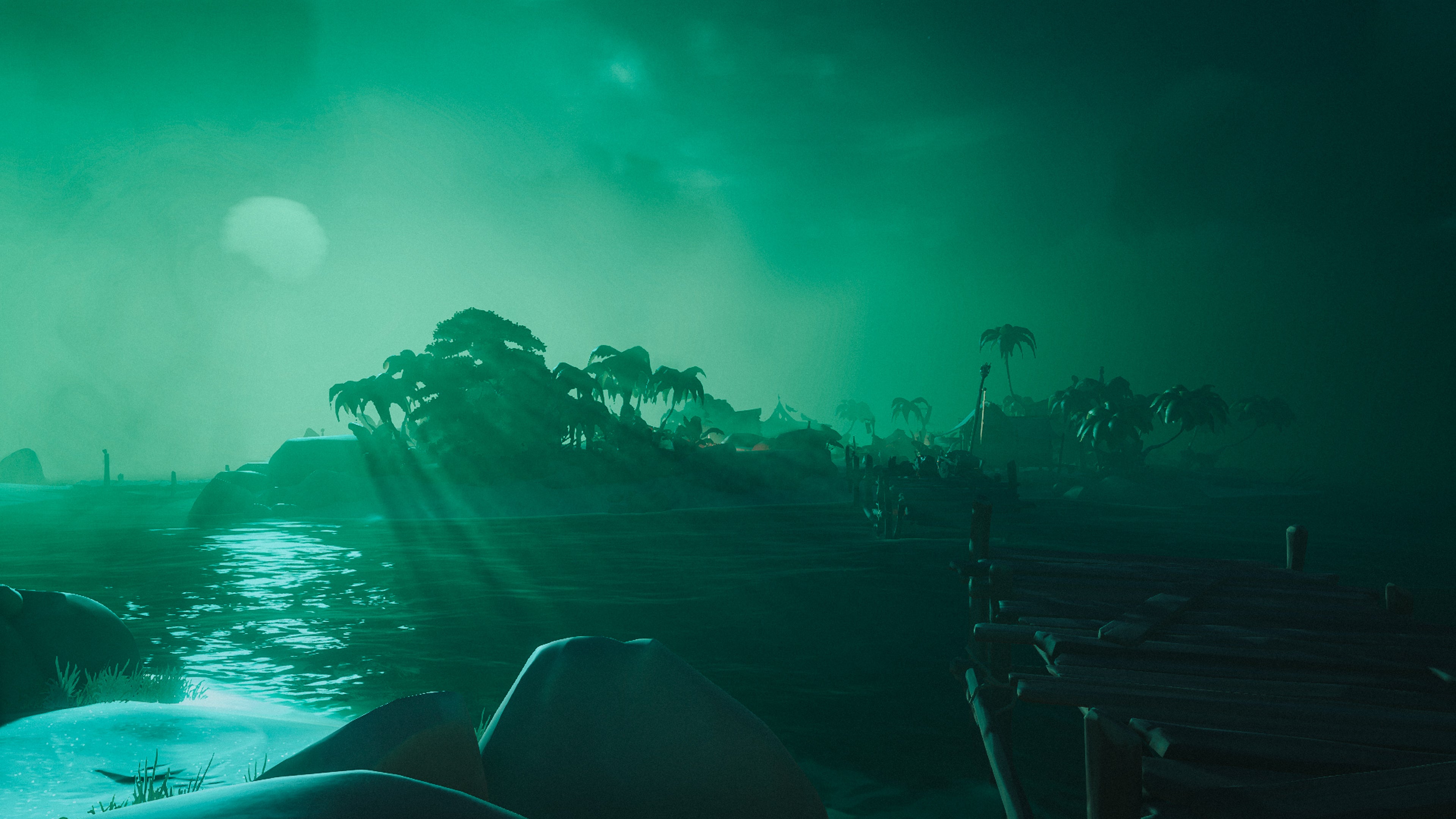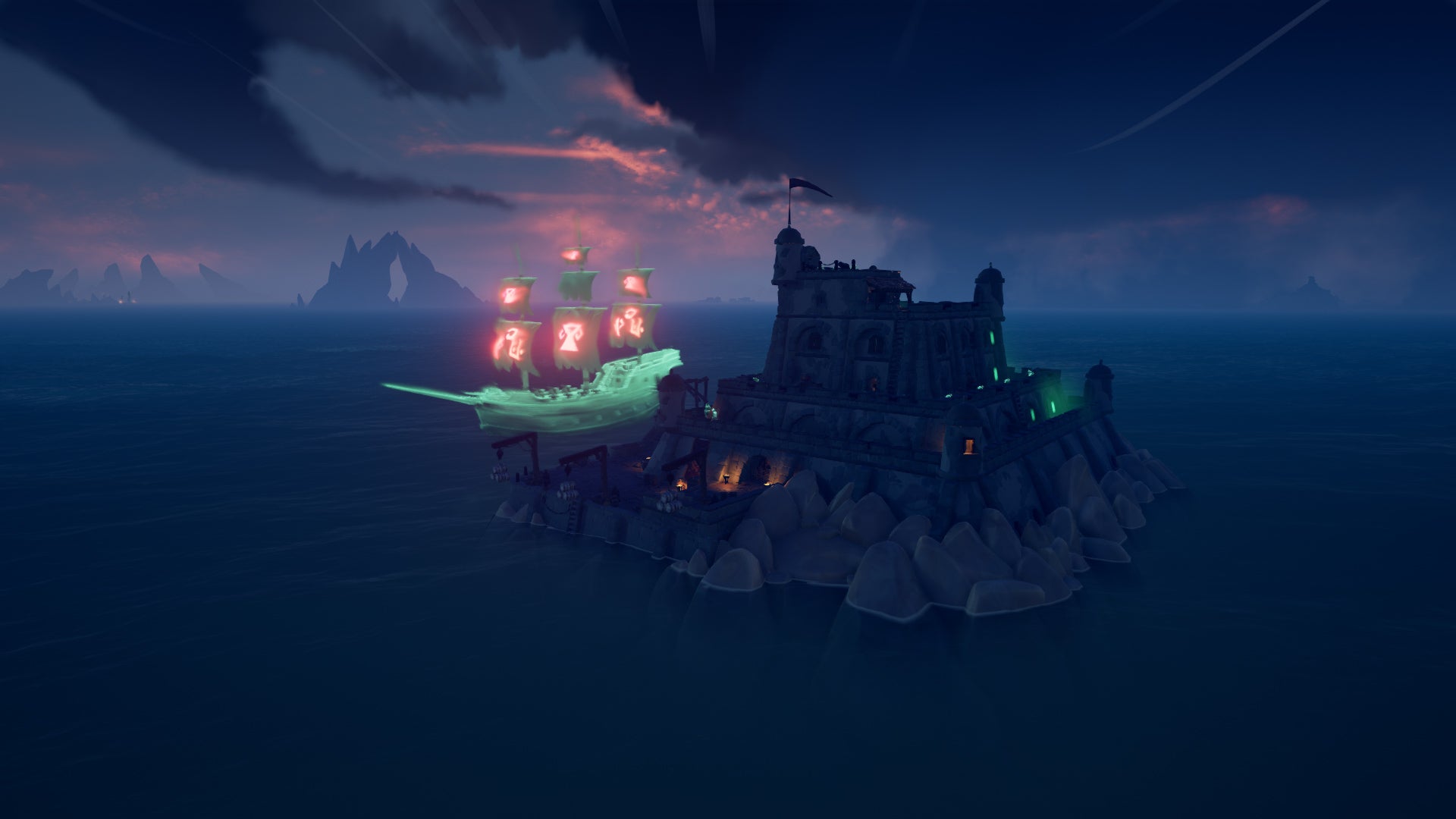It was, on the whole, a welcome change; the game had already come a long way since it first launched in 2018, but players appreciated the regularity and transparency of the new structure, while the Renown system felt like a slower (but more reliable) way of earning rewards than we’d seen previously. Yeah, another crew might get the better of you before you can actually offload any of your hard-earned treasure, but by that point you’ve probably gained a few levels and got a cool new cannon for your boat anyway, so… fine? But with Season Six, Rare is changing things up once again. Previously, a new season would begin, and all the new content would drop on the same day. But now, the developers are introducing it gradually. And I think it might be brilliant. Here’s how it’s unfolded so far. The main thrust of Season Six’s events actually started towards the end of Season Five, when a number of the game’s islands were suddenly beset by a weird green fog. One of them was Golden Sands, normally one of the game’s most picturesque outposts. In addition to it being all dark and spooky, it was very clear that some kind of battle had taken place, and the NPCs who normally inhabit the island had all vanished. It’s hard to overstate how brilliantly unnerving this was. To see a typically bustling island, a place of safety you’ve visited dozens or even hundreds of times suddenly abandoned, with no clue as to the welfare or location of its residents. In truth, I’d never cared too much about Sea of Thieves’ story or characters, but fair play to Rare – this got my attention. Then, we were given a new mini-voyage to get the ball rolling on working out what had actually happened. Honestly, this was a bit of a let-down. It essentially involved sailing to another island, battering some ghosts and setting fire to some lanterns. Sure, it was clearly too soon to fully reveal what had taken place at Golden Sands, but players expected perhaps a little more. Then Season Six kicked off for real, with the addition of Sea Forts. Pitched as a quick but lucrative activity for time-poor players, they absolutely delivered on that front but also suggested a wealth of untapped potential. Essentially you’d sail up to a fort, fight a load of ghosts either from the safety of your ship or by setting foot in the fort itself (while some absolutely sensational flamenco music kicks in) then hoover up a load of treasure from the fort’s vault. But what of the locked jail cell with creepy arcane sigils drawn on the floor? The central chamber, complete with tables, grog barrels and a huge world map? The dozens of openable boxes and cabinets with absolutely sod-all in them? Rare suggested that players could take and hold a fort “for role-playing purposes”, which is secret code for “there isn’t any tangible reward for doing this”. That said, it’s a known fact that Sea of Thieves players will go to extraordinary lengths to mess with each other, so it’s totally plausible that I’ll one day try to take a fort only to find that it’s full of other players hiding in barrels. But still, it was clear that this was a foundation for things to come. Then, most recently, we were given a new adventure to take part in – having received word that the residents of Golden Sands were being held captive in the Sea Forts, players set about the perfectly enjoyable business of freeing them, concluding with a tease that the next chapter is going to involve hunting a bloody megalodon. And now, despite some slightly underwhelming sections, everything about the new season structure is suddenly starting to click. This isn’t just a series of content drops – it’s a story, playing out in real time. Sea of Thieves’ world has never been completely static, of course; there’s always been an ongoing story to reflect changes and additions to the various factions or locations. But the more active pacing of those events is allowing the world to breathe in a way it hasn’t before. It’s entirely possible that the idea of drip-feeding the content came about purely to prevent the most active players from running out of new things to do within the first week of each season, but even if that is the case, it’s given us something much more wonderful. Something that feels a lot like… oh god, it’s Destiny 2, isn’t it? If you’re not aware, Destiny 2 also turned to a seasonal structure some years ago, also featuring a battle pass progression system with a load of mini-objectives to tick off. Destiny 2’s seasons then also went through a transformation where story events would unfold week-by-week, giving the game a much greater sense of weight… even though players were still pretty much doing the same seasonal activity over and over again. A particular shout-out goes to Season of the Splicer, which dealt with a refugee crisis among one of Destiny’s ‘enemy’ races, and the personal and political upheaval this caused among the game’s supposed heroes; genuinely interesting and affecting stuff from the Shooting Aliens Forever With Your Mates game. To be clear, nobody’s accusing Rare of poaching ideas. While it’s not hard to imagine that Destiny 2’s ongoing success has been an influence, it’s taking the ideas and absolutely making them its own. For starters, the pacing is different. While Sea of Thieves has an incredibly dedicated community, it’s also always held a certain appeal for people who don’t necessarily have time to keep up with a behemoth like Destiny 2. Bungie does allow players to catch up on past events in the current season, so it’s not the end of the world if you miss a week or two. But if you then spend an evening smashing through several weeks of the story, it kills the pacing somewhat. Rare, meanwhile, is giving everyone a couple of weeks to get involved in each new adventure – and if you miss one, it’s gone forever. The other key difference is that Destiny 2’s regularly unfolding story mostly provides context to players repeating the same seasonal activity ad infinitum, while each new nugget of story in Sea of Thieves accompanies a genuinely new activity of some kind, even if they are much less frequent. There’s room for both approaches, of course – this isn’t a case of one being better than the other. It’s also entirely possible that the link between the two games doesn’t actually exist outside of my own imagination. But in any case, it’s interesting to see two games trying similar things, but in ways that make sense for the worlds they’ve created and the communities that have grown around them. And, with Sea of Thieves has been wrestling with something of an identity crisis for some time, it’s giving me hope that the game can look forward to being in its best shape – ever – if Rare sticks the landing with this seasonal approach. Now if you don’t mind, I’m off to see a man about a megalodon.



